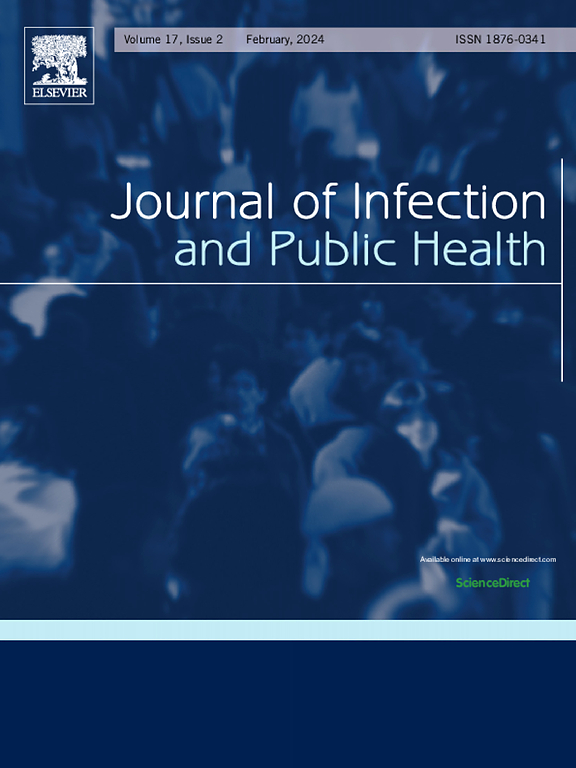泰国Ratchaburi市蝙蝠蝇(双翅目:夜蛾科和链蝇科)和其他体外寄生虫的分子监测:在人畜共患外溢风险背景下,揭示宿主关联和冠状病毒传播动态
IF 4.7
3区 医学
Q1 INFECTIOUS DISEASES
引用次数: 0
摘要
蝙蝠是各种体外寄生虫的宿主,包括蝙蝠蝇、虫子、跳蚤、蜱虫和螨虫,这些寄生虫在蝙蝠传播的病原体中起着至关重要的作用。作为专性吸血寄生虫,这些体外寄生虫可作为直接媒介或间接影响蝙蝠种群中的病原体动态。在泰国,对蝙蝠体外寄生虫的分子研究有限,缺乏关于其多样性、分布和在人畜共患病原体传播中的作用的数据。本研究旨在首次对泰国拉差武里的蝙蝠蝇和其他体外寄生虫进行分子表征,重点研究它们的血食及其与冠状病毒传播的潜在关系。方法采用细胞色素氧化酶I (COI)基因鉴定寄主寄生虫,采用细胞色素b (CytB)基因鉴定寄主血粕。共分析了37只蝙蝠蝇和其他体外寄生虫(蜱和跳蚤)。通过靶向扩增RNA依赖性RNA聚合酶(RdRp)基因进行冠状病毒筛查,对阳性样本进行测序和系统发育分析。结果共鉴定出3个蝇属:Nycteribia sp.(20)、Phthiridium sp.(15)和Raymondia sp.(2)。血粉分析结果显示,蜱虫属寄主与鞘翅鼻虫有亲缘关系,蜱虫属寄主与pusillus和Chaerephon plicatus有亲缘关系,Raymondia属寄主与pusillus有亲缘关系,蜱虫属蜱2只,Hystrichopsylla属蚤1只,均与plicatus有亲缘关系。冠状病毒筛查发现了阳性样本,测序显示了甲型冠状病毒和乙型冠状病毒。结论本研究强调了分子工具在表征体外寄生虫、其血源和相关病原体方面的重要性。它强调了体外寄生虫作为在蝙蝠中检测冠状病毒的非侵入性工具的潜力,可以填补知识空白,并有助于减轻人畜共患病溢出风险的公共卫生战略。本文章由计算机程序翻译,如有差异,请以英文原文为准。
Molecular surveillance of bat flies (Diptera: Nycteribiidae and Streblidae) and other ectoparasites in Ratchaburi, Thailand: Unraveling host associations and coronavirus transmission dynamics in the context of zoonotic spillover risk
Background
Bats act as hosts for various ectoparasites, including bat flies, bugs, fleas, ticks, and mites, which play crucial roles in the transmission of bat-borne pathogens. As obligate blood-feeding parasites, these ectoparasites can serve as direct vectors or indirectly influence pathogen dynamics in bat populations. In Thailand, molecular studies on bat ectoparasites are limited, with scarce data on their diversity, distribution, and role in zoonotic pathogen transmission. This study aims to provide the first molecular characterization of bat flies and other ectoparasites in Ratchaburi, Thailand, focusing on their blood meals and potential involvement in coronavirus transmission.
Methods
Ectoparasites were identified using the cytochrome oxidase I (COI) gene, while host blood meals were confirmed using the cytochrome b (CytB) gene. A total of 37 bat flies and additional ectoparasites (ticks and flea) were analyzed. Coronavirus screening was conducted through targeted amplification of the RNA-dependent RNA polymerase (RdRp) gene, followed by sequencing and phylogenetic analysis of positive samples.
Results
Three bat fly genera were identified: Nycteribia sp. (20), Phthiridium sp. (15), and Raymondia sp. (2). Blood meal analysis indicated host associations with Rhinolophus coelophyllus for Nycteribia sp., R. pusillus and Chaerephon plicatus for Phthiridium sp., and R. pusillus for Raymondia sp. Additionally, two Ixodes sp. ticks and one Hystrichopsylla sp. flea were found, all associated with C. plicatus. Coronavirus screening identified positive samples, with sequencing revealing alphacoronaviruses and betacoronaviruses.
Conclusions
This study highlights the importance of molecular tools in characterizing ectoparasites, their blood meal sources, and associated pathogens. It underscores the potential of ectoparasites as non-invasive tools for coronavirus detection in bats, addressing knowledge gaps and contributing to public health strategies for mitigating zoonotic spillover risks.
求助全文
通过发布文献求助,成功后即可免费获取论文全文。
去求助
来源期刊

Journal of Infection and Public Health
PUBLIC, ENVIRONMENTAL & OCCUPATIONAL HEALTH -INFECTIOUS DISEASES
CiteScore
13.10
自引率
1.50%
发文量
203
审稿时长
96 days
期刊介绍:
The Journal of Infection and Public Health, first official journal of the Saudi Arabian Ministry of National Guard Health Affairs, King Saud Bin Abdulaziz University for Health Sciences and the Saudi Association for Public Health, aims to be the foremost scientific, peer-reviewed journal encompassing infection prevention and control, microbiology, infectious diseases, public health and the application of healthcare epidemiology to the evaluation of health outcomes. The point of view of the journal is that infection and public health are closely intertwined and that advances in one area will have positive consequences on the other.
The journal will be useful to all health professionals who are partners in the management of patients with communicable diseases, keeping them up to date. The journal is proud to have an international and diverse editorial board that will assist and facilitate the publication of articles that reflect a global view on infection control and public health, as well as emphasizing our focus on supporting the needs of public health practitioners.
It is our aim to improve healthcare by reducing risk of infection and related adverse outcomes by critical review, selection, and dissemination of new and relevant information in the field of infection control, public health and infectious diseases in all healthcare settings and the community.
 求助内容:
求助内容: 应助结果提醒方式:
应助结果提醒方式:


